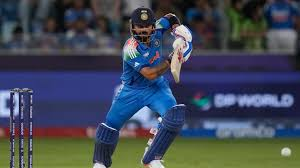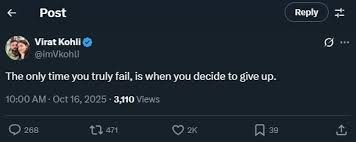Virat Kohli’s viral post on X before the IND vs AUS ODI series surprises fans as it turns out to be a cleverly disguised advertisement
Perth / New Delhi, October 2025 — In a twist sure to stir cricket fans, what initially appeared as a deeply personal social media post by Virat Kohli ahead of India’s much‑anticipated ODI series in Australia has been revealed to be a promotional teaser for his clothing brand. The revelation has sparked disappointment among fans, a wave of memes, debates about authenticity in athlete communications, and fresh scrutiny of athlete endorsement strategies.
Kohli, known for being selective about what he shares on social platforms, posted a cryptic message on X (formerly Twitter) shortly after landing in Perth:
“The only time you truly fail is when you decide to give up.”
Given the timing — just ahead of a return to ODIs after a period of limited white-ball appearances — the post quickly fueled speculation. Was Kohli sending a personal statement about his form, career, or mindset heading into the crucial India vs Australia series?
However, roughly an hour and a half later, Kohli clarified (implicitly) through a follow-up video and campaign rollout that the post was part of a teaser for an advertisement for his brand Wrogn.
“Failure teaches you what victory never will,” the campaign video caption read.
The revelation prompted strong reactions across the cricket and general public, with many fans expressing a sense of being misled. Some felt it was clever marketing; others felt disappointed at the blurred lines between public sentiment and commercial messaging.
Below, we unpack what happened, how the public responded, what this means for athlete branding in India, and where things might go next.
Timeline & context: how the post unfolded

Arrival in Australia + speculation
On October 16, 2025, Team India arrived in Australia, and Kohli’s arrival in Perth was followed by the cryptic social media message.
Many fans interpreted the message as a possible emotional or motivational cue from Kohli, especially given the looming ODI series starting October 19 and rising speculation about his future in limited-overs cricket.
Because Kohli rarely posts personal or introspective content on X — he tends to limit social media output to brand partnerships, match updates, or greetings — the message stood out.
The post goes viral & public reaction
Minutes after posting, the message spread rapidly. Fans, media, cricket commentators, and social media users tried reading into the words — was it a signal about his dedication, a response to critics, or a hint about his role in upcoming matches?
As speculation mounted, critics and eager followers dissected every word, asking: was this a personal philosophy, or was there greater meaning relating to 2027 World Cup prospects, form, or selection?
The reveal: ad campaign
Shortly thereafter, the veil lifted. The post, it turned out, was a teaser for a campaign under Kohli’s clothing label Wrogn.
The video associated with the campaign expanded on the message: “Failure teaches you what victory never will.”
Many fans expressed disappointment, saying they felt tricked into overinterpreting what was essentially brand marketing packaged as a personal insight.
Some defended Kohli’s marketing acumen — noting how he generated buzz, got free publicity, and engaged his audience deeply. Others, however, expressed frustration at the marketing masquerade.
In the days after, meme‑creators had a field day, circulating images and jokes about “Vir(ad) Kohli” and how marketing and sentiment were merged.
One user quipped:
“Scammed more than half of Cricket Twitter.”
Another:
“Vir(ad) Kohli.”
Reaction threads highlighted both amusement and annoyance at what was perceived as “clickbait-style” marketing.
Analysis & implications
Athlete branding in the digital age
Kohli’s post is a textbook example of how modern athletes (especially those with high social media followings) can leverage intrigue, ambiguity, and personal branding to drive engagement.
- The cryptic post piqued curiosity and speculation.
- The reveal tied the emotional weight of the original message to a brand narrative.
- The strategy effectively turned fans into participants in a marketing story, rather than passive consumers.
But there is a wrinkle: the more such strategies blur the line between genuine personal expression and commercial messaging, the more audiences may question the authenticity of athlete communication.
Over time, if fans grow wary or feel manipulated, the trust and goodwill that stars like Kohli have built might erode (at least partially). There’s a delicate balance between smart marketing and overreach.
Risk of backlash & diluted credibility
Some risks come into play:
- Perceived deception: Fans who believed it was a heartfelt message may feel misled when they see it was an advertisement. That can lead to resentment.
- Diluted sincerity: When every post is suspected to be a marketing campaign, genuine expressions lose impact.
- Brand risk: If reactions turn negative, the brand being promoted (Wrogn, in this case) may absorb backlash by association.
In Kohli’s case, reactions so far seem mixed — a blend of amusement, criticism, and some who admired the calculated move.
Relevance to his cricket journey & public image
Because the post coincided with speculation about his ODI role and 2027 World Cup planning, many fans were eager to interpret deeper meaning. The reveal might dampen sincere conversation about Kohli’s future, as some will treat all posts as marketing going forward.
Still, the move underscores how modern cricketers are not just sports figures but media-savvy brands themselves. In an era when social media presence and persona matter, such tactics are sometimes seen as necessary to stay relevant and monetise influence.
Response from team management, media & selectors
Reaction is likely coming from multiple quarters:
- Media and cricket analysts: Some may criticize the maneuver as manipulative, while others respect its marketing ingenuity.
- Team management / selectors: They may prefer players to maintain focus on cricket and avoid stunts that distract from performance narratives.
- Fans & public: Many will watch how Kohli responds on the field now — whether his performance justifies or undermines the build-up.
How this compares with other sports & global athlete campaigns
Globally, elite sports personalities often walk the line between content creators, influencers, and brand ambassadors. Cryptic posts, teaser campaigns, and “authenticity behind the scenes” reveals are common in entertainment and consumer brands. Athletes do this too. The challenge is local audiences are more sensitive to sincerity, especially in sports where emotional connection is strong.
Kohli’s case may serve as a cautionary or instructive example for other athletes in India on how to design such strategies — what works, what alienates.
Reaction highlights & fan sentiment
Below are some of the reactions and observations surfacing on social media:
- Many fans felt betrayed: “I was inspired until I realized it was just an ad.” (Reddit thread)
- Meme culture exploded: “Vir(ad) Kohli,” “Baited us all,” and other jokes about marketing masquerade.
- Some defended it: “The statement is still meaningful even if it’s an ad.”
- Questions about frequency: Will fans now treat every emotionally toned post as sponsored?
These reactions show how fragile the line between engagement and disillusionment can be in social media communication.
What’s next: what to watch
- On‑field performance
Kohli’s performance in the ODI series may now be viewed through the prism of this promotional buildup — fans will watch keenly for whether he backs up the sentiment. - Future social content
Will Kohli scale back cryptic posts? Will brands and influencers become more cautious? Observers will watch how his content strategy evolves. - Branding guidelines / transparency
There may be calls (from fans, media) for clearer labeling of promotional content by athletes, especially when it closely mimics personal messaging. - Reputation management
How Kohli and his team respond to criticism or redemption gestures will matter. An honest take or explanation might ease backlash. - Industry learning
Other athletes and celebrity marketers may use this as a case study — what worked, what alienated, what metrics (engagement, conversion) justified the risk.
Also Read : Mumbai stock investor, wife lose Rs 58 crore in ‘digital arrest’ fraud; 3 mule account holders arrested















 Categories
Categories








